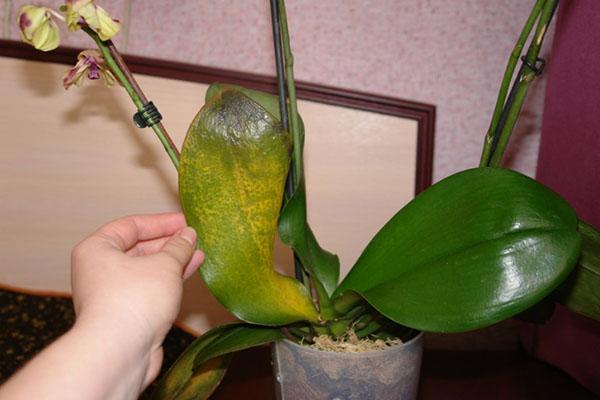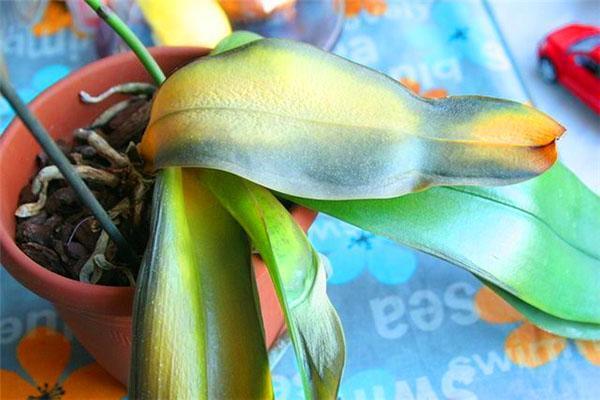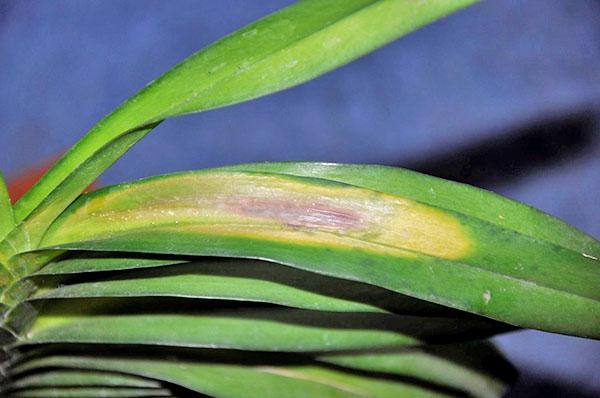Exploring Orchid Diseases and Plant Rescue
 It is not a problem to have a beautiful butterfly flower in the house. Improper care is the cause of orchid disease. The advice of amateurs is at times exactly the opposite. There are signs by which even an inexperienced amateur will understand the reason for the change in the color and shape of the leaves. Improper care and its consequence occurs when the basic rules for keeping an orchid are not followed.
It is not a problem to have a beautiful butterfly flower in the house. Improper care is the cause of orchid disease. The advice of amateurs is at times exactly the opposite. There are signs by which even an inexperienced amateur will understand the reason for the change in the color and shape of the leaves. Improper care and its consequence occurs when the basic rules for keeping an orchid are not followed.
Photos of orchid diseases and their treatment with a description

The most common type of orchid in cultivation is Phalaenopsis. It is easier to care for him when kept in a room.
In order not to wonder if the orchid is sick, what to do, you need to avoid:
- improper watering;
- dry air around the flower;
- improper lighting;
- temperature collapse;
- underfeeding and overfeeding;
- diseases transmitted by insects and air;
- open infected wounds on the plant.
The consequences of improper maintenance are expressed in the weakening of the plant. Orchids often suffer from over-attention. Orchid diseases can be divided into groups:
- wrong containment regime;
- diseases brought in by parasites;
- fungal, viral and bacterial diseases;
- mechanical damage.
Any orchid disease begins with neglect.
Lighting
 Improper lighting may result in sheet burns. Even the spring sun can be fatal if the orchid is not gradually taught to it. Lack of lighting will lead to elongated growth. If the situation is not corrected, the flower will die. Artificial lighting should be carried out with cold glow lamps installed at least 30 cm from the sheet. An incandescent lamp will burn the sheet.
Improper lighting may result in sheet burns. Even the spring sun can be fatal if the orchid is not gradually taught to it. Lack of lighting will lead to elongated growth. If the situation is not corrected, the flower will die. Artificial lighting should be carried out with cold glow lamps installed at least 30 cm from the sheet. An incandescent lamp will burn the sheet.
Watering
 If the leaves of an orchid wither, one of the reasons may be a violation of the watering regime. The orchid grows in a pot with transparent walls. The roots take part in photosynthesis and deliver moisture to the leaves. Therefore, leaf lethargy occurs from prolonged drying of the plant or excessive watering. If the plant is very dry in summer, and even with dry air, the leaves will lose tugor. In order not to create a greenhouse effect, the room is ventilated. It is important that the roots dry completely between waterings. In a constantly moist substrate, root rot will begin and the leaves of the orchid will also wither.
If the leaves of an orchid wither, one of the reasons may be a violation of the watering regime. The orchid grows in a pot with transparent walls. The roots take part in photosynthesis and deliver moisture to the leaves. Therefore, leaf lethargy occurs from prolonged drying of the plant or excessive watering. If the plant is very dry in summer, and even with dry air, the leaves will lose tugor. In order not to create a greenhouse effect, the room is ventilated. It is important that the roots dry completely between waterings. In a constantly moist substrate, root rot will begin and the leaves of the orchid will also wither.
If the plant is set to be saturated with water when watering and forgotten for a day, the leaves will swell. This means that the plate is saturated with water, swollen, and weeping spots appeared on it. During this time, the plant is vulnerable to any infection.
Orchid flowers have different scents but do not cause allergies. The smell of rotten meat and the aroma of vanilla create one kind of flowers. For better pollination, the petals hold the visiting insect.
Edema is especially dangerous when over-watered in cool weather. At a temperature of about 15 degrees, watering should be reduced, weeping spots should be dried with filter paper so that they do not grow.At this time, you cannot spray the orchids on the leaves.
 If it is in a draft at sub-zero temperatures, the plant will die for several hours.
If it is in a draft at sub-zero temperatures, the plant will die for several hours.
Weakened orchids colonize spores and myceliums. Rot is formed. Sometimes plants are bought with tubercles on the leaves, in which the infection is dormant. Infection can occur through the ground, by air.
 Fungal diseases of orchid leaves are presented in the photo.
Fungal diseases of orchid leaves are presented in the photo.
The tubercles of the mycelium on the leaves of Phalaenopsis cannot be opened. It is better to destroy such leaves so as not to spread the infection. The new leaves will be clean.
Roots can be affected by rot, leaves by spotting, anthracosis and powdery mildew. Each disease has its own symptoms, but it is primarily a violation of the content.
Rot can be of different colors - brown, black, gray, but the orchid can be preserved only in the initial stage, by cutting and disinfecting all infected areas. You need to take a new pot and substrate, sterilize the instrument. If the rot has spread throughout the root, the plant must be destroyed.
 Leaf spot is caused by abundant watering and excess fertilization. Weeping spots appear on the fleshy loose plate - this is a spot. It is necessary to change the conditions for keeping the flower and remove all affected parts of the plant. Phalaenopsis suffers from this orchid disease. As a control measure, the plant is dried and treated with fungicides.
Leaf spot is caused by abundant watering and excess fertilization. Weeping spots appear on the fleshy loose plate - this is a spot. It is necessary to change the conditions for keeping the flower and remove all affected parts of the plant. Phalaenopsis suffers from this orchid disease. As a control measure, the plant is dried and treated with fungicides.
Anthracosis is another disease that begins with leaf spots. Small brown spots grow, necrotic attacks appear. High humidity, stagnant water on the leaves and lack of ventilation are the causes of the disease. Long-term treatment. It is necessary to remove the affected parts, after treatment with the fungicide three times after 10 days.
 If the affected leaves are covered with a white coating on top, it is powdery mildew. The humid, damp warm air provoked the development of dormant spores. A solution of colloidal sulfur, Fitosporin and a change in conditions of detention will help.
If the affected leaves are covered with a white coating on top, it is powdery mildew. The humid, damp warm air provoked the development of dormant spores. A solution of colloidal sulfur, Fitosporin and a change in conditions of detention will help.
Viral diseases are determined by mosaic leaves, small spots. They are transmitted by insect pests that are vectors. Such diseases are not cured. The plant is removed.
Why do sticky spots appear on orchid leaves
 Aphids, whiteflies, mealybugs can inhabit a weakened plant. With frequent wiping of the sheets with a damp cloth, pests will be found quickly, and it will not be difficult to get rid of them. The greatest harm to orchids is caused by the scale insect, which sits tightly on the leaf, feeds on juice and secretes a sticky secret, on which a sooty mushroom settles. As a result, sticky spots appear on the orchid leaves. You can remove the shield with an alcohol solution. If there are many pests, Fitoverm will save. But it is necessary to change the pot and soil.
Aphids, whiteflies, mealybugs can inhabit a weakened plant. With frequent wiping of the sheets with a damp cloth, pests will be found quickly, and it will not be difficult to get rid of them. The greatest harm to orchids is caused by the scale insect, which sits tightly on the leaf, feeds on juice and secretes a sticky secret, on which a sooty mushroom settles. As a result, sticky spots appear on the orchid leaves. You can remove the shield with an alcohol solution. If there are many pests, Fitoverm will save. But it is necessary to change the pot and soil.
Hello! Tell me what it is and how to treat it.
Apparently, your orchid is of venerable age, and besides, it is rotting. The lower roots are almost completely affected, there is no point in leaving them - they will still disappear over time. You can try to rejuvenate the plant, especially since there are five completely healthy-looking roots in the upper part.
I would cut off the entire bottom half to healthy green roots (bottom right three pieces and top left two). You also need to completely remove the stump that was cut off earlier (in the photo it is green on top), since it is also sick. With a sharp knife, carefully cut out a black speck at the beginning of the sheet. Treat the rest of the root fungicide, sprinkle the slices with charcoal and leave the orchid for three hours to dry well. Accordingly, a new substrate should also be taken. The leaves themselves can be rubbed with succinic acid. If you do not leave foci of decay, the flower can be revived.
Thanks for the advice.
What to do?
Most likely, insects hunted here, what holes they made. Such leaves will no longer recover, it is better to cut them off, and treat the remaining ones with Fitoverm, Aktellik or Aktara. It does not hurt at the same time to check the roots - suddenly a fungus or a virus has crept in there and also finish off the flower from the inside.
Hello) Can you please tell me how to help your pet?
It will soon fall out of your pot right out of the pot, and the roots are visible rotten. Transplant urgently. Free from old bark, rinse (you can add potassium permanganate), cut off all roots that are not green and not fleshy. Wet, black, dry - all this must be removed. Sprinkle the slices with crushed charcoal and dry well. You can leave it until evening. Take the soil mixture fresh, after transplanting, wipe the leaves with succinic acid.
Hello! Can you please tell me what the plant lacks?
There can be many reasons, from care miscalculations to diseases, you cannot tell right away. In any case, it does not hurt to check what is going on in the pot, whether the roots have rotted, because the reason may lie in them. If you really find roots that are black or thin as threads, cut off and rinse all like them in potassium permanganate. Let the orchid dry for 5-6 hours and only then plant it in fresh substrate.
Please tell me what is on the leaves
What a disease do my orchids have
It is not a disease. The purple tint (especially from the inside of the leaf) is a semblance of plant pigmentation. It manifests itself in orchids that bloom purple, burgundy or beetroot.
Hello, is this a burn? And how to help black spots?
The root system is not visible in the photo. Perhaps you overdid it with watering. Check the roots. Wipe the leaves with a solution of succinic acid.
Thank you so much
Kind time of the day, help me figure out what the problem is, what's with the leaf?
Hello. Please tell me what's wrong with my flower?
Remove the affected orchid leaf and dry stalks as soon as possible. Treat with fungicide, not forgetting about the soil.
Hello, tell me, what's with the leaf?
Hello. Please tell me what it is. It appeared in one day. The leaves in these places are wet, like burst blisters from a burn
To me, these spots are most similar to wet bacterial rot. Most often it is provoked by an excess of moisture. The bad news is that the disease quickly spreads both through the diseased plant and spreads to neighboring plants. The flower needs to be urgently separated, and the place where it stood should be treated with bleach. Cut / cut all affected areas on the leaves. Treat the cut sites with copper sulfate. Ordinary, "human" drugs, such as tetracycline or miramistin, also work well. After processing, it is important to keep the orchid on a "dry ration" for 2 weeks - do not spray, do not wipe the leaves, water carefully, a little along the edge of the pot.
Hello, tell me what is wrong with her and how to treat it? THANK
The dark spots indicate that the orchid is rotting. Most likely, the same process exists in the root system. Maybe you poured it in by accident or didn't drain the water after irrigation? Get out and inspect the roots urgently. The diseased leaf must be carefully broken off, and the rotten roots must be cut off. Flower - treat with fungicide and change the soil.
Can you please tell me what it is and how to deal with it?
The top leaf does not grow, wrinkles from below, I have already removed 2 of these from above, gave a near-stem baby, I separated it, now the peduncle, but the leaves are bad, they turned black at the edges, I cut it off. What about the flower, tell me please?
The top leaf does not grow, wrinkles from below, I have already removed 2 of these from above, gave a near-stem baby, I separated it, now the peduncle, but the leaves are bad, they turned black at the edges, I cut off. What's wrong with the flower, tell me please? Here is another photo
I would check the roots, if they are missing, it is not surprising that the plant does not have enough strength to develop the aboveground part. In addition, if there is an infection in the pot, the disease could have already spread to the leaves. Remove from the flowerpot, inspect the roots, everything that has rotted, cut it off, treat it with a fungicide. Dry and plant in fresh soil.
First, one of the four tsvntonos turned yellow on the orch. After a while, the flowers on the second and third wilted and black spots appeared on them. The fourth peduncle with one flower and a bud, which seems to be in coma for a month, since it does not open, is in a normal state so far. Tell me what is it?
It looks like a fungal disease, sometimes it manifests itself on flowers without first affecting the leaves. Remove all spotted flowers, change soil with careful root inspection and fungicide treatment.
Thank you, Olga, I did just that yesterday
I bought cambria from the markdown, transplanted it, processed it with phytoverm. Here are spots on 2 leaves. Please tell me what it is and how to save it? The orchid bloomed
Most similar to the onset of anthracnose disease. Isolate the flower, cut off the stained leaves, sprinkle on the cuts, dry. Treat with a fungicide such as Skor or Ridomil. Fitoverm will not help here - it is against pests.
Good afternoon, today I found something near a new root, the orchid has recently bloomed, released a new leaf, it seems to take off well, but I am confused by this process (I don't even know what to call it) Please tell me what is it?)
I've never seen this. Maybe this new peduncle can not get out and twirled?
I bought an orchid and transplanted it. After a while, small tubercles began to appear, opened up, processed the pits with propolis infusion. There are more of them. Is it a fungus? Is there anything you can do? The orchid is blooming.
Can't you see the insects? These may be traces of their activity, the juice has been sucked out and the site has died out. If you do not find anyone, then it is very similar to the beginning of the development of anthracnose, when pads with spores already appear on the spot of the spots. We'll have to remove the diseased leaf so that the disease does not go further. Treat the cut with charcoal or ash, and the whole orchid with a fungicide. Copes well with anthracnose Ridomil, Skor, Topsin-M.
There is also something on the back of another sheet
Hello, tell me what to do with the orchid, in which the top leaf turned yellow and blackened - I just cut it off - and immediately the next top leaf also turned black and yellow (
The fact that it turned black is bad, most likely it is a disease. I would examine the roots, they can rot too. These should be cut off. Treatment with a fungicide will not hurt and it is necessary to replace the substrate.